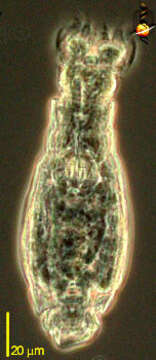portrait

Description:
This is a bdelloid rotifer (metazoa), body with a stiffened body wall (lorica) usually in elements that will telescope, posterior end often with two spurs. Very common in aquatic habitats especially those which are prone to dry out - like moss, soils and the contents of pitcher plants. They can resist drying because they can perform cryptobiosis - that is they can dry out completely, and the organisms can come back to life when wetted. Usually eat bacteria or suspended protists, using the cilia of the corona at the front end of the body to sweep particles into the front of the body where an armoured mastax or jawed pharynx helps to grind the food. Rotifers are common members of the microbial communities of many aquatic ecosystems. Although they are multicellular animals, they may be only 100 microns long, and so overlap in size with ciliates. They can be confused with ciliates because they use cilia to capture their food. However, they can be distinguished because many have an exoskeleton and a muscular pharyngeal region just behind the head. Phase contrast.
Included On The Following Pages:
- Metazoa (Animal)
- Rotifera (rotifers)
- Eurotatoria
- Life (creatures)
- Cellular (cellular organisms)
- Eukaryota (eukaryotes)
- Opisthokonta (opisthokonts)
- Bilateria
- Protostomia (protostomes)
- Spiralia (spiralians)
- Gnathifera
- Syndermata
- Bdelloidea
- Philodinidae
This image is not featured in any collections.
Source Information
- license
- cc-by-nc
- author
- David Patterson and Richard Snyder
- provider
- micro*scope
- original
- original media file
- visit source
- partner site
- micro*scope
- ID


